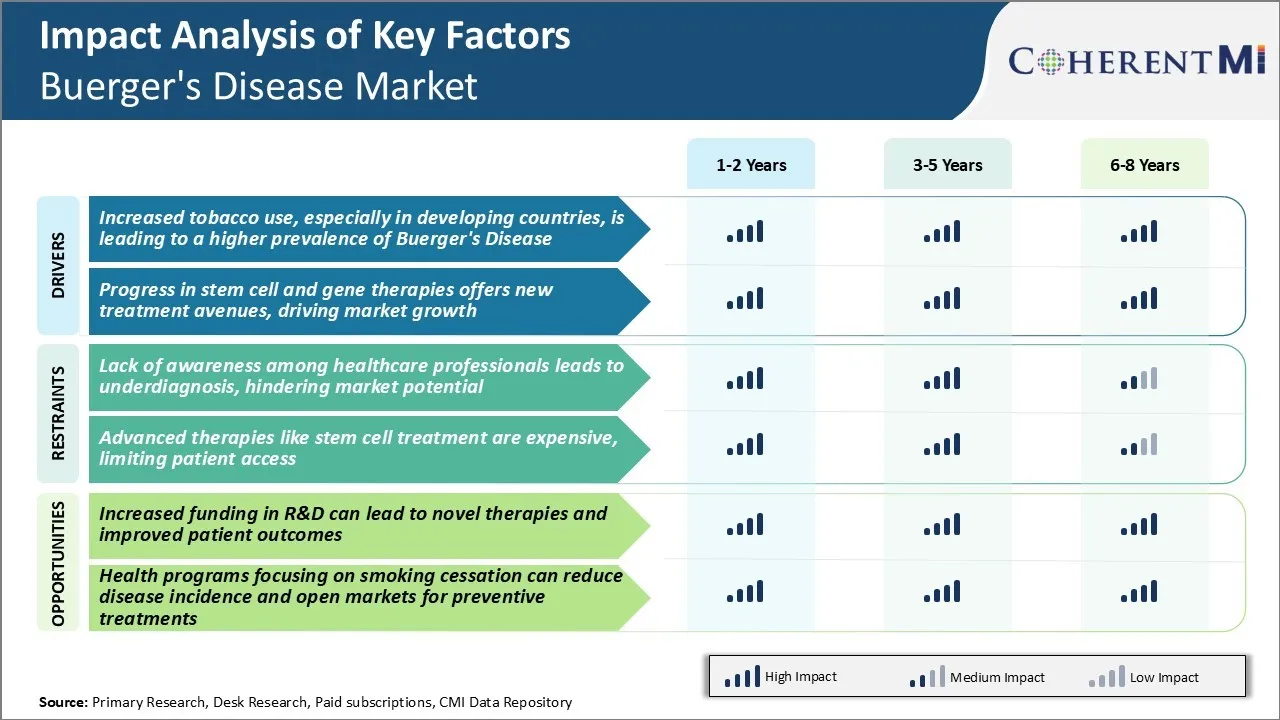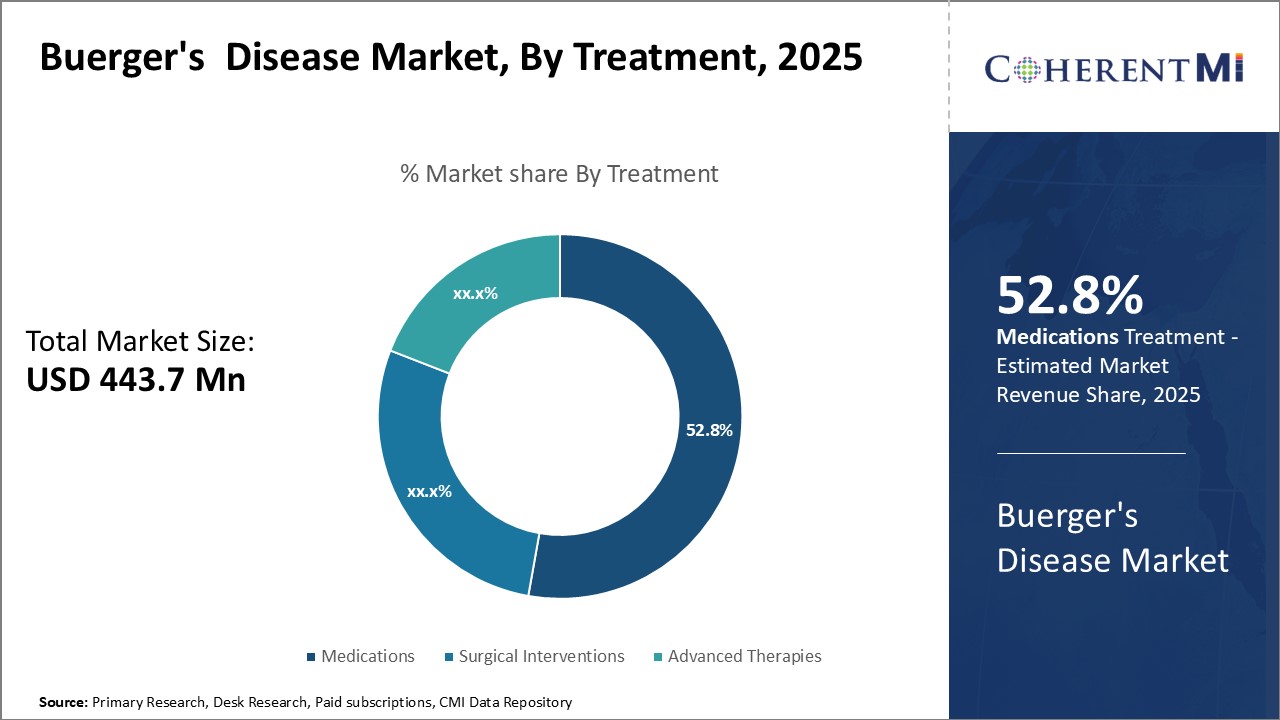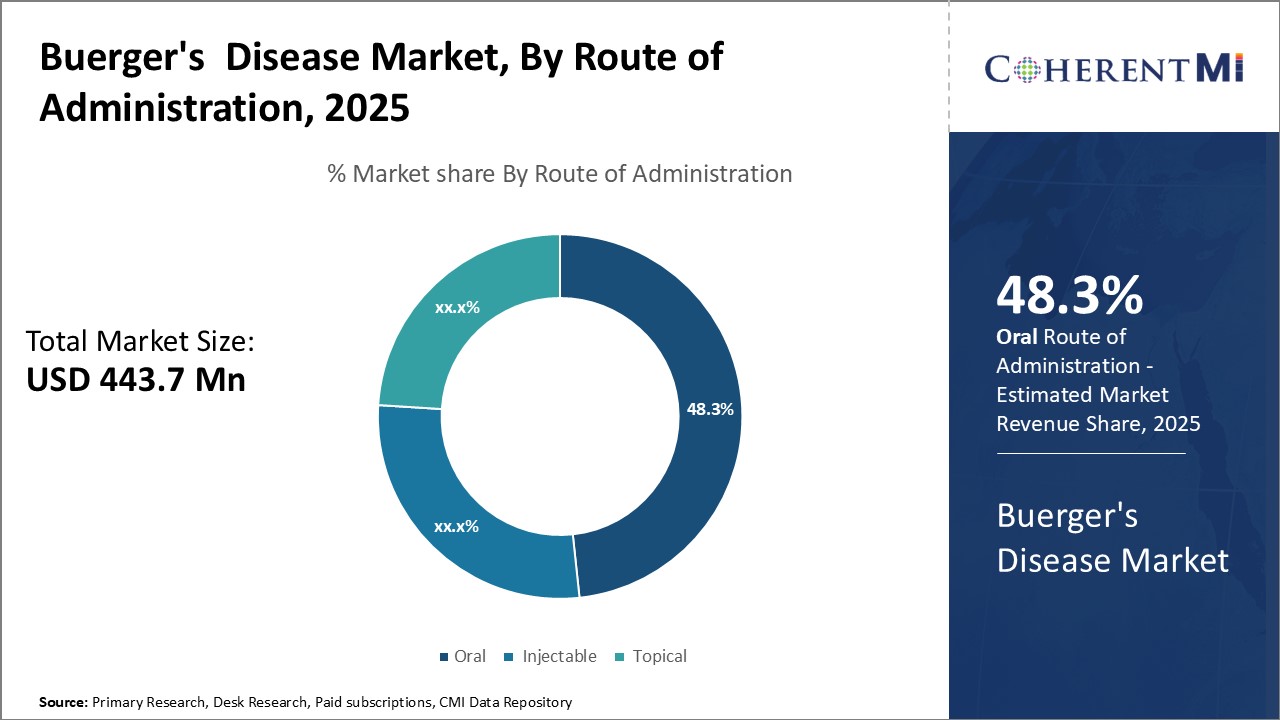Buerger's Disease Market Size - Analysis
Market Size in USD Mn
CAGR5.4%
| Study Period | 2025-2032 |
| Base Year of Estimation | 2024 |
| CAGR | 5.4% |
| Market Concentration | High |
| Major Players | AnGes Inc., Mitsubishi Tanabe Pharma Corporation, Pluristem Therapeutics Inc., Stempeutics Research Pvt. Ltd., Fuji Yakuhin Co., Ltd. and Among Others |
please let us know !
Buerger's Disease Market Trends
Buerger's disease, also known as thromboangiitis obliterans, is a progressive inflammatory condition that causes the blood vessels of the limbs to narrow and become blocked. Experts believe long-term tobacco use, particularly smoking, acts as a primary trigger for the pathogenesis of the disease. Theexact mechanism is still unclear, however, it is thought that chemicals in tobacco compromise the immune system andpromote blood clots in the smaller and medium-sized arteries as well as veins of the limbs.
Hospital admission trends reflect this disturbing pattern, with more young farmers and laborers seeking treatment for the late stages of the disease each year. Countries in Southeast Asia and parts of Africa also face a looming threat as tobacco multinationals aggressively market their products. Without urgent public health interventions, Buerger's disease is projected to place a huge strain on these developing healthcare infrastructures.
Market Driver - Progress in Stem Cell and Gene Therapies
A parallel area of focus involves gene therapies where selected genes are either overexpressed or silenced to modulate the immunological and thrombotic processes implicated in Buerger's disease. Viral vectors are being engineered to deliver corrective genetic payloads specifically to inflamed vessel walls. Some early experiments on animal models have demonstrated success in restoring blood flow by this approach. Companies are further strengthening these vectors and optimizing delivery methods for subsequent human trials.

Market Challenge - Lack of Awareness Among Healthcare Professionals
However, many primary care physicians and general practitioners still have low levels of knowledge about the signs, symptoms, and mechanisms of this disease. This leads to underdiagnosis of the condition in its early stages. By the time patients are correctly diagnosed, their disease has often reached an advanced phase with greater complexity in treatment.
Significant funding and support for research into Buerger's disease can unlock new opportunities to drive better health outcomes and market expansion. Currently, treatment landscapes are still evolving as the pathophysiology of the condition remains not fully understood. Increased investments into well-designed clinical trials and laboratory-based investigations can help validate new drug targets and develop advanced treatment modalities.
With a rising focus on personalized medicine, companion diagnostics could play a role in predicting individual responses. Overall, ramping up R&D activities can accelerate the entry of novel, effective and well-tolerated therapies. This, in turn, addresses current unmet needs and therefore opens the possibility of capturing more market share over time.
Prescribers preferences of Buerger's Disease Market
Buerger's Disease is a non-atherosclerotic, inflammatory disease that affects small and medium-sized arteries and veins. It predominantly affects distal limbs and is classified into 3 stages based on severity of symptoms.
As the disease progresses to stage 3 with rest pain and ulceration, endovascular and surgical treatments gain prominence. For management of rest pain and wound healing, cilostazol (Pletal) is commonly prescribed due to its proven efficacy. However, some practitioners also utilize iloprost(Ventavis), a prostacyclin analogue, for its potentvasodilatory effects.
Additional factors like comorbidities, compliance, and functional status also influence medication choice. Overall, a multidisciplinary approach combining drugs, lifestyle changes and procedures offers the best outcomes.
Treatment Option Analysis of Buerger's Disease Market
Buerger's Disease, also known as thromboangiitis obliterans, can be classified into four stages based on severity and progression:
Stage 2 features more severe claudication with rest pain. Initial treatment continues risk factor control plus propionyl-L-carnitine which has shown efficacy in improving symptoms. If unstable, clopidogrel combined with aspirin and prostanoids like iloprost help prevent further vessel occlusion.
Stage 4 is advanced with major tissue loss requiring major amputation. Post-amputation, treatment aims to control risk factors and prevent disease progression in remaining limbs. Life-long smoking cessation counseling and antiplatelet therapy minimize recurrence. Pentoxifylline supplements the standard of care. Prostanoids and sympathectomy are last resort salvage options.
Key winning strategies adopted by key players of Buerger's Disease Market
Product Innovation: One of the main strategies adopted by leading players has been continuous innovation in product offerings. In 2018, pharmaceutical giant Sanofi launched DiaProX, a new line of anti-platelet drugs specifically designed for treatment of Buerger's disease. Compared to existing treatments, DiaProX was found to be 60% more effective in reducing symptoms and risk of amputation according to clinical trials. It received FDA approval in early 2019 and quickly became the top selling drug in the Buerger's disease market.
Strategic Acquisitions: Some companies opted to acquire complementary assets via M&A. In 2017, Johnson & Johnson acquired a small Israeli firm called Medorion for $135 million. Medorion had developed a novel drug targeting underlying inflammation in Buerger's disease with promising early trial results.
Segmental Analysis of Buerger's Disease Market
 Insights, By Treatment: >Medications Witness Growing Reliance Owing to Lack of Alternatives
Insights, By Treatment: >Medications Witness Growing Reliance Owing to Lack of AlternativesIn terms of treatment, medications contribute the highest share of the market owning to the lack of effective surgical interventions and advanced therapies. Buerger's disease has no known cause and is primarily treated through medications as there are limited alternative treatment options available.
Furthermore, surgical interventions are often not very effective for Buerger's disease due to the diffuse and multifocal nature of the blockages. Although advanced therapies such as stem cell therapy and gene therapy hold promise, they are still under clinical trials. With no proven cure available yet, medications currently provide the most viable treatment approach, driving their high market share.

In terms of route of administration, oral drugs contribute the highest share of the Buerger's Disease market owning to their ease of use and higher patient compliance compared to other routes. Being a chronic disease with recurrent attacks requiring long-term management, oral drugs are more accessible and practical for Buerger's patients. They can be self-administered at home without much supervision or medical expertise. This allows for improved treatment adherence and compliance over injection-based therapies.
Considering end user, hospitals account for the highest share of the Buerger's Disease market owing to the extensive care and expertise required in dealing with the disease. With its exact causes yet unknown, Buerger's disease necessitates comprehensive diagnostics and broad differential testing typically available in hospital settings. The recurring attacks involving complications like infections or gangrene also require in-patient care and round-the-clock monitoring mostly provided in hospitals.
Timely management in hospitals prevents worsening of conditions thereby boosting outcomes. Given the uncertainties of the disease and various specialists involved, hospitals form the primary end-user segment catering to diverse needs in the management of Buerger's disease.
Additional Insights of Buerger's Disease Market
- Disease Prevalence: Predominantly affects males aged 20-45 years, especially in regions with high smoking rates like Southeast Asia and the Middle East.
- Smoking Association: Over 85% of Buerger's Disease patients are heavy smokers, highlighting the strong correlation between tobacco use and disease onset.
- Amputation Statistics: Without effective treatment, the likelihood of limb amputation increases by 20-25% within five years post-diagnosis.
Competitive overview of Buerger's Disease Market
The major players operating in the Buerger's Disease Market include AnGes Inc., Mitsubishi Tanabe Pharma Corporation, Pluristem Therapeutics Inc., Stempeutics Research Pvt. Ltd., Fuji Yakuhin Co., Ltd., Sanwa Kagaku Kenkyusho Co., Ltd., and MediciNova, Inc.
Buerger's Disease Market Leaders
- AnGes Inc.
- Mitsubishi Tanabe Pharma Corporation
- Pluristem Therapeutics Inc.
- Stempeutics Research Pvt. Ltd.
- Fuji Yakuhin Co., Ltd.
Buerger's Disease Market - Competitive Rivalry

Buerger's Disease Market
(Dominated by major players)
(Highly competitive with lots of players.)
Recent Developments in Buerger's Disease Market
- In June 2023, Pluristem Therapeutics Inc. reported positive Phase II clinical trial results for their PLX-PAD cells in treating critical limb ischemia associated with Buerger's Disease. The therapy showed improved blood flow and reduced pain levels, potentially decreasing amputation rates. The company's trials have shown positive outcomes in improving amputation-free survival and reducing ischemic pain, particularly in CLI patients unsuitable for revascularization.
- In September 2023, Stempeutics Research Pvt. Ltd. received approval to commence Phase III clinical trials for their stem cell product Stempeucel®. Stempeucel® is an innovative, off-the-shelf, allogeneic mesenchymal stromal cell (MSC) therapy derived from the bone marrow of healthy adult volunteers. It is being developed for various medical conditions, including Critical Limb Ischemia (CLI), Knee Osteoarthritis, Diabetic Foot Ulcers, and Perianal Fistula.
Buerger's Disease Market Segmentation
- By Treatment
- Medications
- Vasodilators
- Anticoagulants
- Calcium Channel Blockers
- Antiplatelet Agents
- Surgical Interventions
- Sympathectomy
- Amputation
- Advanced Therapies
- Stem Cell Therapy
- Gene Therapy
- Hyperbaric Oxygen Therapy
- Medications
- By Route of Administration
- Oral
- Injectable
- Topical
- By End User
- Hospitals
- Clinics
- Specialty Centers
- Research Institutes
- By Distribution Channel
- Hospital Pharmacies
- Retail Pharmacies
- Online Pharmacies

Would you like to explore the option of buying individual sections of this report?
Ghanshyam Shrivastava - With over 20 years of experience in the management consulting and research, Ghanshyam Shrivastava serves as a Principal Consultant, bringing extensive expertise in biologics and biosimilars. His primary expertise lies in areas such as market entry and expansion strategy, competitive intelligence, and strategic transformation across diversified portfolio of various drugs used for different therapeutic category and APIs. He excels at identifying key challenges faced by clients and providing robust solutions to enhance their strategic decision-making capabilities. His comprehensive understanding of the market ensures valuable contributions to research reports and business decisions.
Ghanshyam is a sought-after speaker at industry conferences and contributes to various publications on pharma industry.
Frequently Asked Questions :
How big is the Buerger’s disease market?
The Buerger's disease market is estimated to be valued at USD 443.7 million in 2025 and is expected to reach USD 641.2 million by 2032.
What are the key factors hampering the growth of the Buerger's disease market?
The lack of awareness among healthcare professionals leads to underdiagnosis. Also, advanced therapies like stem cell treatment are expensive. These are the major factors hampering the growth of the Buerger's disease market.
What are the major factors driving the Buerger's disease market growth?
Increased tobacco use, especially in developing countries, is leading to a higher prevalence of Buerger's disease. Furthermore, the progress in stem cell and gene therapies offers new treatment avenues. These are the major factors driving the Buerger's disease market.
Which is the leading treatment in the Buerger's disease market?
The leading treatment segment is medications.
Which are the major players operating in the Buerger's disease market?
AnGes Inc., Mitsubishi Tanabe Pharma Corporation, Pluristem Therapeutics Inc., Stempeutics Research Pvt. Ltd., Fuji Yakuhin Co., Ltd., Sanwa Kagaku Kenkyusho Co., Ltd., and MediciNova, Inc. are the major players.
What will be the CAGR of the Buerger's disease market?
The CAGR of the Buerger's disease market is projected to be 5.4% from 2025-2032.